Make delicious orange soaked baba napolitana
You might be familiar with rum babas? This is the Italian version, hailing from Napoli. It’s often made for celebrations including Christmas.
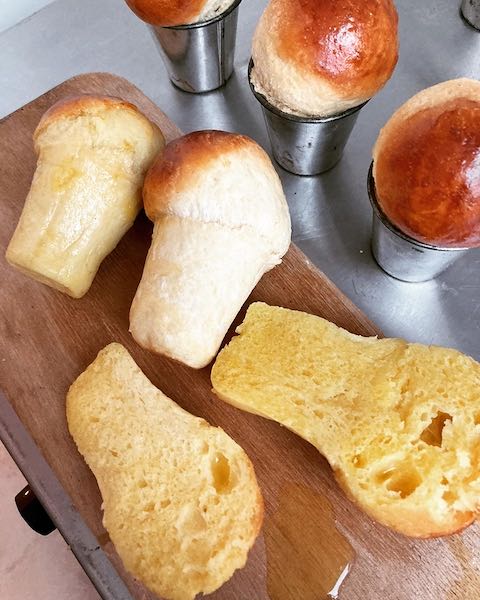
It’s a lovely light dough, easy to make that keeps very well. The citrusy flavours really make this bread something special. I like to serve it with a selection of berries for dessert. If you’re not a fan of rum, an orange liqueur such as cointreau works really well.
Don’t be tempted to use plain flour in this recipe, Type 00 flour is very fine. Use bread flour instead. You can make the dough in advance and put in the fridge overnight.
This recipe uses pate fermentee (PF) rather than a pre-ferment. This can be added to any breads you might make. The recipe follows the Baba Napolitano recipe.
Make Baba Napolitano
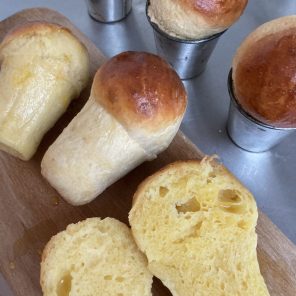
Baba Napolitano
Equipment
- Stand Mixer with dough hook
- Food processor (or grinder)
- Digital scales
- 8 dariole moulds (or muffin tins or ramekins)
- Pastry Brush
- Plastic boxes to store dough (or use your stand mixer bowl and cover it)
- Vegetable peeler
- Citrus juicer
- Dough scraper or plastic spatula
- Metal spatula
- Baking parchment or silicon sheet
Ingredients
Pate Fermentee
- 200 grams bread flour or Type 45 /Type 00
- 130 millilitres water
- 5 grams fresh yeast or half a sachet of quick action yeast
- 2 grams salt
Baba Dough
- 250 grams flour (Type 00 or Type 45)
- 100 grams Pate Fermentee (PF)
- 75 grams butter
- 25 grams caster sugar
- 150 millilitres whole egg about 3 eggs
- 5 grams salt
- 12 grams fresh yeast or 7 gr packet of fast action yeast
- 1 egg for egg wash
- Extra butter and flour for the moulds
Rum and Citrus soaking mixture
- 1 large Orange zest peeled
- 1 lemon zest peeled
- 200 millilitres granulated sugar
- 200 millilitres water
- Rum to taste (approx 30 ml)
Instructions
Dough
- Put the flour, PF, sugar, eggs, salt and yeast in your stand mixer bowl.
- Using a dough hook, mix for 5 minutes on low speed and 5 minutes on medium speed.
- Turn the speed back to low and add the butter in small lumps. To begin with, it will look as if it will mix in, it will!
- Mix until the mixture comes away from the sides and the dough measures between 24 and 26°C. This is typically a further 5 minutes.
- Leave at room temperature for an hour. Either place a plate on top of your bowl or put it into a plastic container with a lid. At this point you can put it in the fridge overnight or for a minimum of 3 hours.
- Make the syrup: Using a peeler, peel the orange and lemon zest off the lemons (it will be easier to remove later). Juice the fruits. Place the sugar, water and juices into a saucepan. Place on a medium heat until the sugar has melted.
- Set aside to cool leaving the peel in the syrup. When cool, add the rum a little at a time, tasting as you go. Do not allow the rum to dominate the orange flavour.
- Remove the dough from the fridge. Divide the dough into six 60 gr pieces. You want your dough to reach 3/4 up the dariole mould. If you are using a different container, use 60-70 gr dough.
- Roll the dough into balls. Then roll more heavily on one side so it will fit the mould.

- Spray the mould with cake release spray or butter it very well and dust with flour.
- Pop the dough into the moulds. Brush with egg. Leave to prove covered at room temperature for 1.5 hours. By this time it will be close to the top of the dariole moulds.
- Pre-heat the oven to 180°C (170C if fan) 30 minutes before you need to use it
- Place the moulds on a baking tray. Coat with beaten egg a second time.
- Bake for approx 20 minutes. Check after 10 and 15 minutes. The dough will have risen well and the top will be golden. Check internal temperature of the baba is more than 90C.
- Allow to cool before gently removing from the mould. Store in the fridge.
- If you can, leave the babas until the next day before soaking. Put the syrup in a deep bowl removing the peel. Prick the babas all over with a sharp knife and soak in the syrup. You’ll probably need to do these two at a time.

- Once they’ve soaked once, soak a second time. Serve warm with baked apples, plums or whatever fruit you wish!
Notes
Pate Fermentee Recipe
Make the amount needed for this recipe or more if you are doing more baking. It keeps well in the fridge for 3-4 days.
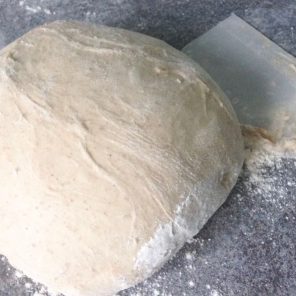
Pate Fermentee – Pre-fermented dough
Ingredients
- 500 grams white bread flour (100%) eg Shipton Mill Organic No. 4, Type 55 or Type 65 French flour
- 5 grams fresh yeast (1%) or dried yeast available from most supermarket bread counters or half sachet of dried ueast
- 5 grams salt (1%)
- 300 millilitres water (60%)
Instructions
- If you are making it in a stand mixer, place all ingredients in the bowl.
- Mix for 3 minutes at a low speed, then a further 3 minutes at medium speed. The dough should come away cleanly from the sides of the bowl. Check the temperature and ensure it reaches between 24 and 26°C (78°F)
- If you are making by hand, place the flour in a large bowl. Rub the fresh yeast into the flour. Add the salt, then the water. Mix well, then knead until smooth – about 10 minutes. Check the temperature and ensure it reaches between 24 and 26C (78F)
- Place the dough in a bowl or box and cover well. Place in the fridge and leave for at least 3 hours. Use within 3-4 days. Keep in the fridge at all times.
- To use, measure 20% of the weight of flour in your recipe of Pate Fermentee (eg 200 gr for 1 kilo of flour) and add it to the other ingredients at the same time as the flour.

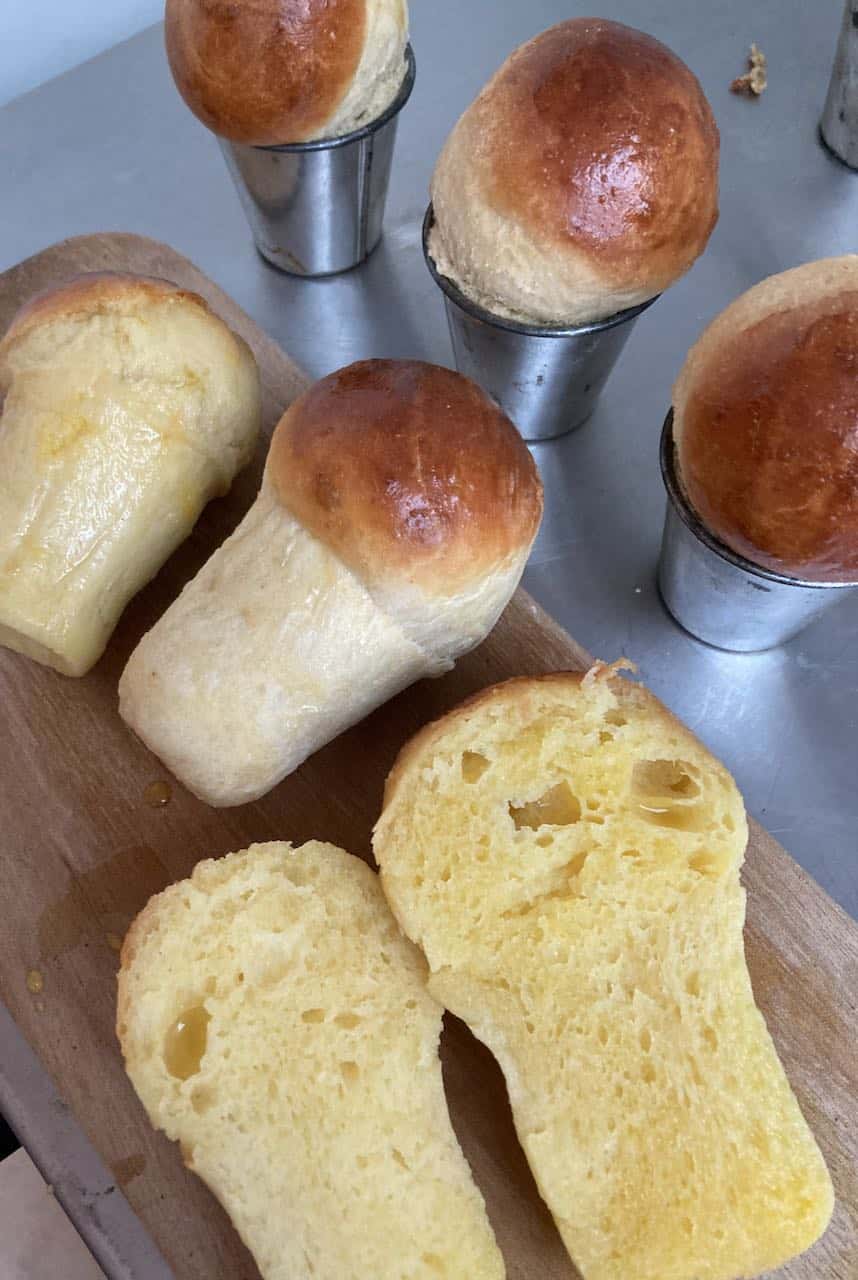
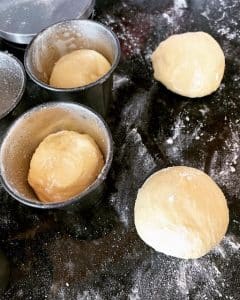
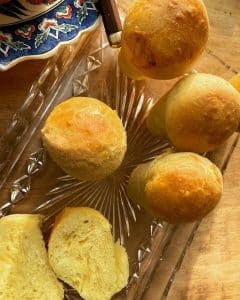
1 thought on “Baba Napolitana”